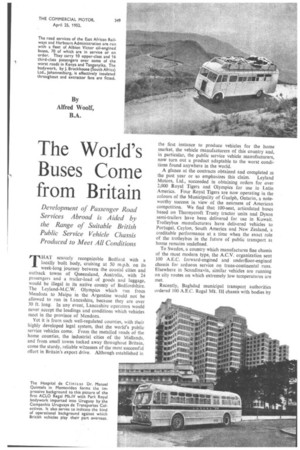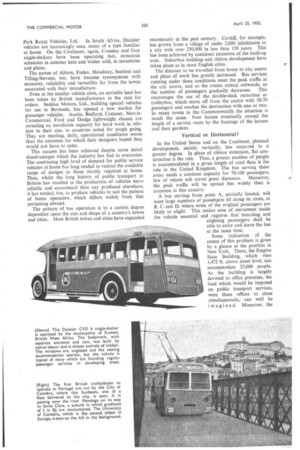The World's Buses Come from Britain
Page 103

Page 104

Page 105

If you've noticed an error in this article please click here to report it so we can fix it.
Development of Passenger Road Services Abroad is Aided by the Range of Suitable British Public Service Vehicle Chassis Produced to Meet All Conditions By Alfred Woolf, B.A.
THAT scarcely recognizable Bedford with a locally built body, cruising at 50 m.p.h. on its week-long journey between the coastal cities and outback towns of Queensland, Australia, with 24 passengers and a trailer-load of goods and luggage, would be illegal in its native county of Bedfordshire. The Leyland-M.C.W. Olympics which run from Mendoza to Maipu in the Argentine would not be allowed to run in Lancashire, because they are over 30 ft. long. In any event, Lancashire operators would never accept the loadings and conditions which vehicles meet in the province of Mendoza.
Yet it is from such well-regulated counties, with their highly developed legal system, that the world's public service vehicles come. From the metalled roads of the home counties, the industrial cities of the Midlands, and from small towns tucked away throughout Britain, come the sturdy, reliable witnesses of the most successful effort in Britain's export drive. Although established in the first instance to produce vehicles for the home market, the vehicle manufacturers of this country and, in particular, the public service vehicle manufacturers, now turn out a product adaptable to the worst conditions found anywhere in the world.
A glance at the contracts obtained and completed In
the past year or so emphasizes this claim. Leyland Motors, Ltd., succeeded in obtaining orders for over 2,000 Royal Tigers and Olympics for use in Latin America. Four Royal Tigers are now operating in the colours of the Municipality of Guelph, Ontario, a noteworthy success in view of the nearness of American competition. We find that 100-seat, articulated buses based on Thornycroft Trusty tractor units and Dyson semi-trailers have been delivered for use in Kuwait. Trolleybus manufacturers have delivered vehicles to Portugal, Ceylon, South America and New Zealand, a creditable performance at a time when the exact role of the trolleybus in the future of public transport at home remains undefined.
To Sweden, a country which manufactures fine chassis of the most modern type, the A.C.V. organization sent 100 A.E.C. forward-engined and underfloor-engined chassis for arduous service on trans-continental runs. Elsewhere in Scandinavia, similar vehicles are running on city routes on which extremely low temperatures are met.
Recently, Baghdad municipal transport authorities ordered 100 A.E.C. Regal Mk. III chassis with bodies by Park Royal Vehicles, Ltd. In South Africa, Daimler vehicles are increasingly seen, many of a type familiar at home. On the Continent, again, Crossley and Guy single-deckers have been operating fast, strenuous schedules in summer heat and winter cold, in mountains and plains.
The names of Albion, Foden, Maudslay, Sentinel and Tilling-Stevens, too, have become synonymous with economy, reliability and versatility far from the towns associated with their manufacture.
Even in the smaller vehicle class, an enviable lead has been taken by British manufacturers in the race for orders. Seddon Motors, Ltd., building special vehicles for use in Bermuda, has opened a new market for passenger vehicles. Austin, Bedford, Commer, MorrisCommercial, Ford and Dodge lightweight chassis are revealing an inordinate capacity for hard work in relation to their size, in countries noted for tough going. They are meeting, daily, operational conditions worse than the extremes for which their designers hoped they would not have to cater.
This success has been achieved despite some initial disadvantages which the industry has had to overcome. The continuing high level of demand for public service vehicles at home has long tended to restrict the available range of designs to those mainly required at home. Thus, whilst the long history of public transport in Britain has resulted in the production of vehicles more reliable and economical than any produced elsewhere, it has tended, too, to produce vehicles to suit the pattern of home operation, which differs widely from that pertaining abroad.
The pattern of bus operation is to a certain degree dependent upon the size and shape of a country's towns and cities. Most British towns and cities have expanded enormously in the past century. Cardiff, for example, has grown from a village of under 2,000 inhabitants to a city with over 250,000 in less than 150 years. This has been achieved by continual extension of the built-up area. Suburban building and ribbon development have taken place as in most English cities.
The distance to be travelled from home to city centre and place of work has greatly increased. Bus services running under these conditions meet the peak traffic at the city centre, and as the routes extend outwards, so the number of passengers gradually decreases. This encourages the use of the double-deck motorbus or trolleybus, which starts off from the centre with 50-70 passengers and reaches the destination with one or two. In many towns in the Commonwealth the situation is much the same. New homes eventually extend the length of a service route by the frontage of the houses and their gardens.
Vertical or Horizontal?
In the United States and on the Continent, planned development, mainly vertically, has occurred to a greater degree. In place of ribbon extension, flat construction is the rule. Thus, a greater number of people is accommodated in a given length of road than is the rule in the United Kingdom. The bus serving these areas needs a constant capacity for 70-100 passengers, few of whom will travel great distances. Moreover, the peak traffic will be spread less widely than is common in this country.
A bus starting from point A, partially loaded, will meet large numbers of passengers all along its route, at B, C and D, where some of the original passengers are likely to alight. This makes ease of movement inside the vehicle essential and requires that boarding and alighting passengers shall be able to enter and leave the bus at the same time.
Some indication of the extent of this problem is given by a glance at the position in New York. There, the Empire State Building, which rises 1,472 ft. above street level, can accommodate 25,000 people. As the building is largely devoted to office premises, the load which would be imposed on public transport services, were these offices to close simultaneously, can well be imagine d. Moreover, the Empire State Building occupies the entire space between two streets (33rd and 34th), fronting on 5th Avenue. An equivalent street length would provide scarcely enough space for one bus stop in Britain, and would be the starting point of only a few passengers.
Then, again, the geometrical pattern of planned cities (found in South as well as North America) results in the maximum number of right-angle intersections in a given length of road. This produces an optimum condition for congestion, and traffic hold-ups in these cities are not only long but difficult to clear.
Average speeds of public services are, therefore, low, especially under peak-hour conditions, when the operator would like them to be at their highest. Average speeds being directly related to revenue, time lost in traffic jams and in picking up passengers is reflected either in the large numbers of vehicles held against peakhour service, or in the extra capacity of the vehicles, useful only in peak hours. It is also seen in the high rate of acceleration required of the buses to make up time after being held up.
Smaller-scale Problems This is completely at variance with conditions at home. The same problems are met, on a smaller scale, but smaller vehicles are used, which occupy less road space whilst offering surplus passenger capacity for peak traffic.
The real root of the problem is glimpsed in population density figures. In 1949, London had a population of 8,500,000 occupying 690 sq. miles. In New York, the population of 7,830,000 occupied only 299 sq. miles. Thus, the comparative density figures were 12,200 per sq. mile in London and 26,200 in New York. This is a measure of the traffic difficulties met in the two cities, even without considering the relative vehicle density per square mile.
In many modern cities in South America—Buenos Aires, for example—the position is similar to that in New York. In Australia and South Africa, statistics recalling those of this country will be found for the larger and longer-established cities. Outside the cities, however, the situation is completely different. There, in the undeveloped regions of the world, a gradual rise in the standard of living is taking place. Men and women are beginning to have money to spend where none was available before. Such conditions herald the beginnings of public transport. For the operator, the problem is not how to cater for the traffic offering, but how to make it.
Here, again, Britain can supply the right tools. These may take the form of the lorry-bus, with which so many services were started in Britain, or they may be inexpensive, reliable vehicles which will run over atrocious roads (if any) long enough and cheaply enough to establish services and make room for larger, heavier and more costly types.
Naturally, the largest demand is from developed centres of population. The need, in this case, is for the latest type of bus, fast, capacious, over 30 ft. long, and powered by an underfloor oil engine of 112-130 b.h.p. In this country, opinion is still divided over the merits of this position for mounting the engine. Abroad, opinion is widely in favour of it.
There, the problem of fitting existing maintenance and service equipment to the needs of underfloor-engined chassis does not arise, for usually new facilities have to be acquired along with the vehicles. Bodywork, too, may be of a type developed regardless of existing prejudices in this country. No set views have been evolved regarding integral or all-metal construction, as is the case in Britain. In many cities, the only other passenger carriers have been trams, and their construction bears little relation to that of to-day's vehicles.
So successful have the newest types of maximumcapacity vehicle been overseas, that the tendency at home is now clearly in favour of them. One-man operation, longer vehicles and single-deckers instead of double-deckers are factors being actively evalumed for use in British cities.
Overseas operators with long experience of British vehicles are in some cases still in favour of the forward




























































































































































































































